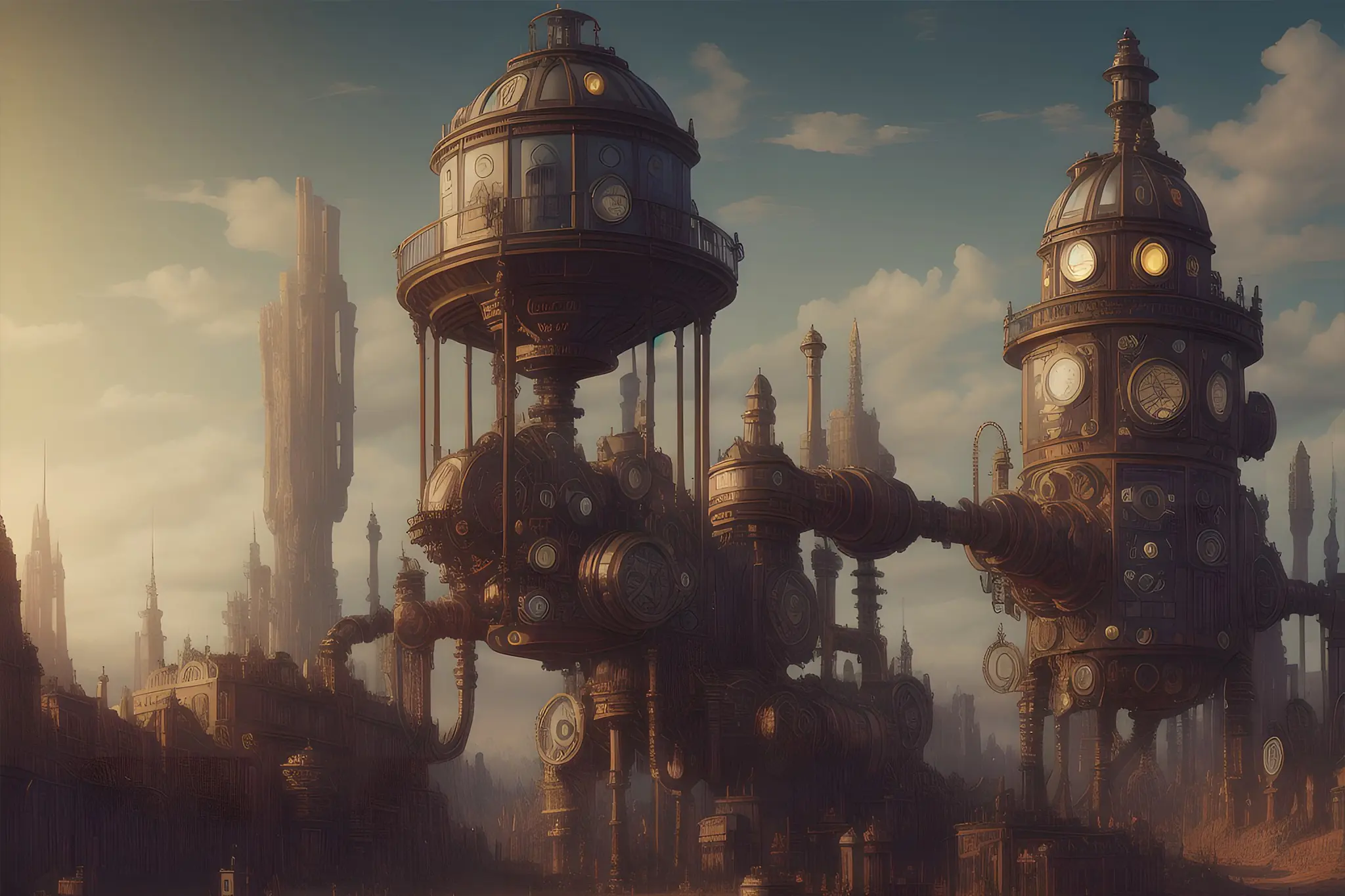I have before me Brian J. Robb’s Steampunk: An Illustrated History of Fantastical Fiction, Fanciful Film and Other Victorian Visions. In this painstakingly researched and illuminating volume on the Steampunk fantasy subgenre, Robb takes us from its roots in experimental Victorian literature to its various manifestations in contemporary pop culture.
I have always found steampunk intriguing, both as a toolbox for storytelling and as a sociocultural phenomenon. The overt celebration of Victoriana and the punky subversion of the Age of the Empire. The lunatic, pince-nez-wearing inventors in plague-doctor long coats. The intricate, steam-powered contraptions and clockwork weaponry. The hunger for geographical and technological exploration.
Empire is an especially important theme because there is something fundamentally grand and industrial about steampunk fiction. The stories often unfurl on the cusp of modern technology; retro-futurist retellings of history in which our innovation tree branched off in a different direction. They harken back to a time when electricity was still some quasi-magical substance, the preserve of hermetic scientists and shadowy cabals. Steam is often the power source of the day instead, giving societies hellbent on discovery, a primitive means by which they could achieve it.
But despite its inherent Britishness, steampunk was pioneered, inadvertently, by three American authors in the 1970s. And it did not take long for it to take over Japanese pop culture.

The Origins of the Steampunk Genre
California State University students James P. Blaylock, Tim Powers and K.W. Jeter would often meet at O’Hara’s pub in Orange County. They’d drink Scotch and smoke cigars, while talk would inevitably turn to the stories they were writing. Though each was working in his own style and fleshing out a distinct creative oeuvre, they were bound by a shared interest in the gloomy, gaslit atmospheres, technological trappings and antiquated language of Victorian-era literature. They had each read the early-sci-fi novels of Jules Verne and H.G. Wells, were familiar with pulp inventor fantasy tales known as the Edisonades (after Thomas Alva Edison), and adored the likes of Charles Dickens, Robert Louis Stevenson and Arthur Conan Doyle.
Jeter felt this inclination towards outdated fiction embodied a punk attitude, and he was the first of the triumvirate to have a steampunk novel in print, 1979’s Morlock Night. Powers then released The Anubis Gates in 1983 before Blaylock published Homunculus in 1986, giving birth to a literary movement.
“Steampunk,” however, wasn’t coined until a year later, when Jeter suggested it as a throwaway term in a letter to Locus magazine:
“Personally, I think Victorian fantasies are going to be the next big thing, as long as we can come up with a fitting collective term for Powers, Blaylock and myself. Something based on the appropriate technology of the era; like ‘steampunk’, perhaps…”
When I started to research the history of steampunk, I was drawn to its connections to Japan. At first, they seemed tenuous: Hayao Miyazaki’s eccentric clockwork designs came to mind, as did the niche alternative history novel Automatic Eve, and iterations of the Final Fantasy and Wild Arms video games. But the more I burrowed down the rabbit hole, the more deeply embedded steampunk appeared to be in domestic pop culture.
This raised an obvious question: How did a Victorian-inspired literary genre, one evoking images of the Nautilus submarine and canon-propelled space shuttles, become a key component of fantasy fiction in the East?

A Perfectly Blended Mix of Genres, Eras and Cultures
Robb draws parallels between the British Empire and Japan’s own imperial regime during the Meiji (1868-1912) and Tasiho (1912-1926) eras. This was Japan’s Belle Époque. The country was expanding its reach and growing in power, emulating the great modern empires of Europe. As Japan globalized and gazed westward with rapt attention, translations of Victorian-era literature appeared on bookstore shelves. Thanks to the authors comprising Japan’s newfound literary class, including Ruiko Kuroiwa, who translated Verne and Wells, the public were given access to the stories in which steampunk had its origins.
Local writers such as Juza Unno, the “father of Japanese science fiction,” and Shunro Oshikawa then began writing proto-steampunk fiction of their own. Oshikawa gave a clear nod to Verne in The Undersea Warship: A Mysterious Story of Island Adventure (1900), about an inventor who creates a submersible ram-ship, while Unno, whose early work was promisingly subversive, was later conscripted as a military propagandist in the 1940s.
In some respects, steampunk’s proliferation in Japan is also down to the definition. “Steampunk [has] split into a head-spinning variety of styles and expressions, all connected to its first formulation through degrees of adoption or execution; there is no such thing as ‘steampunk’, only individual interpretation of it,” notes Robb in Steampunk: An Illustrated History’s introduction. “It’s a Frankenstein genre, stitched together from an innovative mix of reality fantasy.”
This sets out a broad landscape in which fiction can be defined as steampunk. But of course, there are familiar tropes: steam-powered machinery and floating dirigibles, brass-valve automatons and period-style clothing, plus central characters exploring the beyond — from the moon to the ocean floor to the center of the earth.

A steampunk-inspired clock designed by Studio Ghibli’s Hayao Miyazaki in Shiodome, Tokyo | Photo by Sean Pavone via Shutterstock
Steampunk Takes Over Japanese Pop Culture
Japanese role-playing games (JRPGs), particularly the Final Fantasy franchise, showcase the adaptability of steampunk. Final Fantasy VI and IX both feature steam-powered machines and show fantastical civilizations early in their industrial development. Final Fantasy VII fuses elements of steampunk and cyberpunk in a story about eco-activists trying to thwart a global corporation that’s depleting the planet’s lifeblood, a mysterious energy source known as mako. And in Final Fantasy X, you’ll find the Al Bhed, a human tribe garbed in gasmasks and goggles, derided for their use of forbidden technological machines called machina.
Robb sees this as a by-product of the gaming medium: “Partly as a reaction to the completely digital 21st century technology that powers the games themselves, the likes of the Final Fantasy series often come steeped in cogwheels, gaskets and regulators, almost as if hoping to conceal the chips and hard drives that actually produce them.”
Manga and anime have explored the steampunk subgenre in depth, too, with artists often imitating their forebears from both Japan and abroad. Visionary auteur Hayao Miyazaki worked on adapting Verne and Conan Doyle in his early years, before co-founding Studio Ghibli. The animation studio is renowned for romanticizing old world values. This often manifests itself as steampunk designs, from the robots in Laputa Castle in the Sky (1986) to the eponymous fortress in Howl’s Moving Castle (2004).
Steamboy (2004), helmed by Akira director Katsuhiro Otomo, wears its inspirations more heavily. The story is set in London in 1866, where global nations meet to showcase the inventions that will drive the world beyond the industrial revolution, and perhaps, into hell. The late 20th-century manga, Steam Detectives borrows from Doyle, following a more compassionate Sherlock Holmes-style detective solving crimes in Steam City. While Super Atragon (1995) is a homage to both Verne and Oshikawa, in which a subterranean kingdom awakens to wage war on earth dwellers, kickstarting a maritime battle of epic proportions.
If you’re of a nostalgic bent, steampunk certainly has a place in the modern world. Advancing AI suggests we could be on the cusp of a new technological revolution — a final revolution — one where the power dynamic between man and machine will shift towards the latter. Steampunk asks us to reflect upon an era where technology’s trajectory wasn’t so clearly defined. The unknowns fostered optimism and bred invention, a style of invention where utility and aesthetics were given equal merit. We don’t really invent anymore. We just innovate and iterate.
Jeter once said, “There’s a humaneness, for lack of a better word, to old stuff — and old ways — that the modern world lacks.” Japan often struggles with this dichotomy. How can it protect the inherently human values underpinning its traditional culture while striving for technological innovation? Perhaps this is why steampunk has found a footing here; because it allows these conflicting ideals to exist in fictional harmony.









